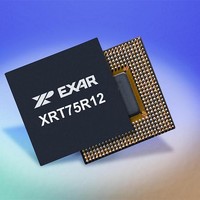XRT75R12DIB-F Exar Corporation, XRT75R12DIB-F Datasheet - Page 128

XRT75R12DIB-F
Manufacturer Part Number
XRT75R12DIB-F
Description
Peripheral Drivers & Components (PCIs) 12 Channel 3.3V-5V temp -45 to 85C
Manufacturer
Exar Corporation
Datasheet
1.XRT75R12DIB-F.pdf
(133 pages)
Specifications of XRT75R12DIB-F
Maximum Operating Temperature
+ 85 C
Minimum Operating Temperature
- 40 C
Mounting Style
SMD/SMT
Operating Supply Voltage
3.3 V to 5 V
Package / Case
TBGA-420
Lead Free Status / RoHS Status
Lead free / RoHS Compliant
- Current page: 128 of 133
- Download datasheet (851Kb)
XRT75R12D
TWELVE CHANNEL E3/DS3/STS-1 LINE INTERFACE UNIT WITH SONET DESYNCHRONIZER
N
Configuring the LIU to be able to comply with the SONET APS Recovery Time Requirements of 50ms
Quite simply, the user can configure a given Jitter Attenuator block (associated with a given channel) to (1)
comply with the "APS Completion Time" requirements per Telcordia GR-253-CORE, and (2) also comply with
the "Category I Intrinsic Jitter Requirements per Telcordia GR-253-CORE (for DS3 applications) by making
sure that Bit 4 (SONET APS Recovery Time Disable Ch_n), within the Jitter Attenuator Control Register is
cleared to "0" as depicted below.
N
Daisy-Chain testing is emerging as a new requirements that many of our customers are imposing on our
SONET Mapper and LIU products. Many System Designer/Manufacturers are finding out that whenever their
end-customers that are evaluating and testing out their systems (in order to determine if they wish to move
forward and start purchasing this equipment in volume) are routinely demanding that they be able to test out
these systems with a single piece of test equipment. This means that the end-customer would like to take a
single piece of DS3 or STS-1 test equipment and (with this test equipment) snake the DS3 or STS-1 traffic
(that this test equipment will generate) through many or (preferably all) channels within the system. For
example, we have had request from our customers that (on a system that supports OC-192) our silicon be able
to support this DS3 or STS-1 traffic snaking through the 192 DS3 or STS-1 ports within this system.
After extensive testing, we have determined that the best approach to complying with test "Daisy-Chain"
Testing requirements, is to configure the Jitter Attenuator blocks (within each of the Channels within the LIU)
into the "32-Bit" Mode. The user can configure the Jitter Attenuator block (within a given channel of the LIU) to
operate in this mode by settings in the table below.
8.8.4
OTE
OTE
B
: The APS Completion (or Recovery) time requirement is 50ms.
: The user can optionally disable the "SONET APS Recovery Time Mode".
R/O
DS3 PPM O
IT
0
7
T
How should one configure the LIU, if one needs to support "Daisy-Chain" Testing at the end
Customer's site?
ABLE
T
51: J
ABLE
FFSET
Unused
B
R/O
IT
0
+10 ppm
+20 ppm
+30 ppm
+40 ppm
+99 ppm
ITTER
6
0 ppm
50: M
(
PER
A
W&G ANT-20SE)
EASURED
TTENUATOR
B
R/O
IT
0
5
APS R
C
ONTROL
SONET APS
Time Disable
(
M
Recovery
ECOVERY
= 0-5 & 8-D) (
Ch_n
B
R/W
IT
0
4
M
R
EASURED
EGISTER
124
T
IME AS A FUNCTION OF
JA RESET
N
= [0:11])
B
Ch_n
R/W
APS R
- C
IT
0
3
HANNEL N
ECOVERY
JA1 Ch_n
1.89ms
1.21ms
1.64ms
1.32ms
1.25ms
1.35ms
, A
B
R/W
T
IT
0
IME
DDRESS
2
DS3
(
PER
PPM OFFSET
JA in Tx Path
L
L
OGIC
OCATION
Ch_n
B
R/W
IT
1
A
1
NALYZER
; 0
XM
JA0 Ch_n
)
7
REV. 1.0.3
B
R/W
IT
1
0
Related parts for XRT75R12DIB-F
Image
Part Number
Description
Manufacturer
Datasheet
Request
R

Part Number:
Description:
Twelve Channel E3/ds3/sts-1 Line Interface Unit With Jitter
Manufacturer:
Exar Corporation
Datasheet:

Part Number:
Description:
BiCMOS Fixed, Quad, Voltage Output, Single or Dual Supply 8-Bit Digital-to-Analog Converter
Manufacturer:
Exar Corporation
Datasheet:

Part Number:
Description:
Manufacturer:
Exar Corporation
Datasheet:

Part Number:
Description:
Voltage-Controlled Oscillator
Manufacturer:
Exar Corporation
Datasheet:

Part Number:
Description:
INTEGRATED LINE TRANSMITTER
Manufacturer:
Exar Corporation
Datasheet:

Part Number:
Description:
Monolithic Function Generator
Manufacturer:
Exar Corporation
Datasheet:

Part Number:
Description:
CMOS Microprocessor Compatible Double-Buffered 12-Bit Digital-to-Analog Converter
Manufacturer:
Exar Corporation
Datasheet:

Part Number:
Description:
CMOS 6 BIT HIGH SPEED ANALOG TO DIGITAL CONVERTER
Manufacturer:
Exar Corporation
Datasheet:

Part Number:
Description:
Manufacturer:
Exar Corporation
Datasheet:

Part Number:
Description:
Manufacturer:
Exar Corporation
Datasheet:

Part Number:
Description:
8-Channel, Voltage Output 10 MHz Input Bandwidth 8-Bit Multiplying DACs with Serial Digital Data Por
Manufacturer:
Exar Corporation
Datasheet:

Part Number:
Description:
15 V CMOS Multiplying10-Bit Digital-to-Analog Converter
Manufacturer:
Exar Corporation
Datasheet:

Part Number:
Description:
Monolithic Function Generator
Manufacturer:
Exar Corporation
Datasheet:










